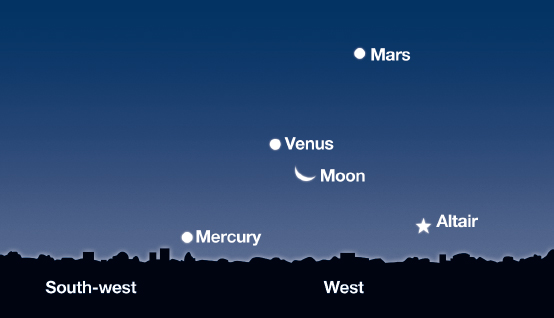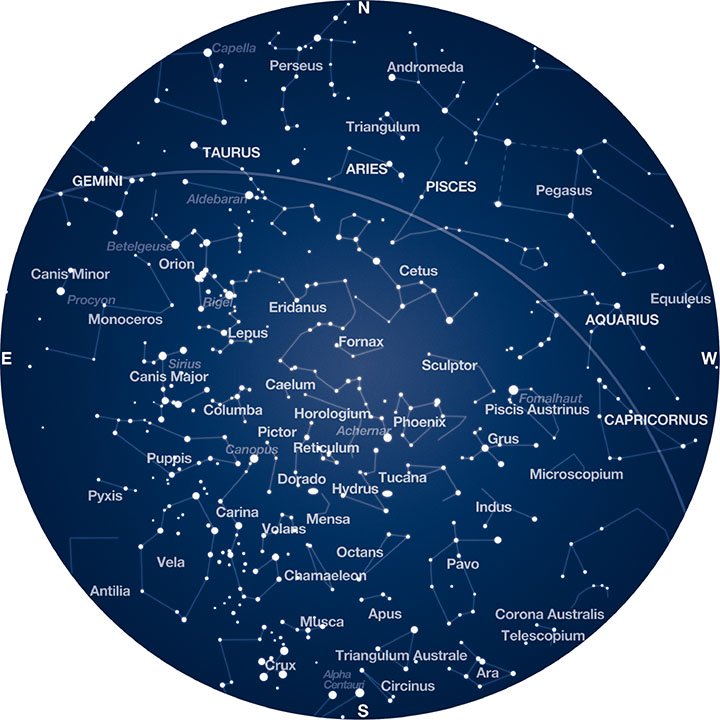
DECEMBER 2015
| KEY |
|
|
|
Bright Star |
|
|
Faint Star |
|
|
Magellanic Cloud |
This sky map shows the ZODIAC CONSTELLATIONS, Non-Zodiac Constellations and Stars of the night sky as seen from Sydney at:
10.30 pm on 7 December
9.30 pm on 21 December
For other dates subtract or add half an hour each week.
The summer constellation of Orion, the Hunter, is high in the south-east. The three stars in the middle of the constellation represent the belt of Orion. Above and a little further to the right or east of the rightmost star of the belt, we find a line of three faint objects, which make up the dagger or sword of Orion. In the middle is one of the most famous sights in the sky, the Great Nebula in Orion. From a city or suburban location, the ‘sword’ is best seen through binoculars.
Extending a line through the stars of the belt towards the right or east, we reach Sirius, the brightest star in the sky. Extending the line in the other direction, we find Aldebaran, the brightest star in the constellation of Taurus, the Bull. Aldebaran’s outer layers are cooler than those of the Sun so it has a noticeably orange colour.
If we extend the line from Orion’s belt further to the left or west, we reach the Pleiades star cluster. To the unaided eye only six or seven stars are visible in the cluster, but through a telescope hundreds of them can be seen. They are at a distance of around 400 light years.
Meteor shower
The Geminid shower, one of the year’s best meteor showers, is a highlight this month. To see the meteors, look towards the north on the early morning of Tuesday 15 December. As there is no Moon in the sky and as the expected peak of the shower occurs during the night (Australian time), this is a particularly favourable opportunity to see the shower.

Mercury appears and becomes the only evening planet.
Mercury appears low in the south-west in Sagittarius just before the middle of the month. On 13 December a thin crescent Moon is above and to the right or west of Mercury.
Morning twilight
Venus is in the east, moving from Virgo into Libra during the second week of the month. On 8 December the crescent Moon is only three moon-widths below Venus.
Mars is in the east in Virgo. On 6 December the crescent Moon is above and to the left or north of Mars.
Jupiter is in the north-east in Leo. On 4 December the crescent Moon is above and to the left or north of the planet, while the next morning it is below and to the right or east.
Saturn appears during the second half of the month low in the east in Ophiuchus.
4:30 am on 8 December — Jupiter, Mars, Venus and the crescent Moon
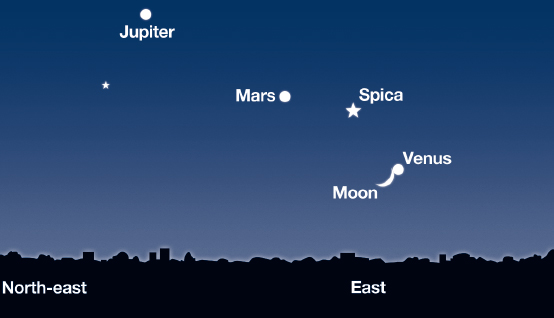

| KEY |
|
|
|
Bright Star |
|
|
Faint Star |
|
|
Magellanic Cloud |
|
|
JUPITER |
This sky map shows the ZODIAC CONSTELLATIONS, Non-Zodiac Constellations and Stars of the night sky as seen from Sydney at:
11.30 pm on 7 January
10.30 pm on 21 January
For other dates subtract or add half an hour each week.
The constellation of Orion is high in the north and dominates the evening sky. It is easily recognisable with four stars in a rectangular pattern and three stars in a row in the middle. These three stars represent the belt of the hunter Orion. Above the right or eastern part of the belt is Orion’s sword, made up of three stars like the belt but much fainter.
If we extend an imaginary line through Orion’s belt to the right or east, we reach Sirius, the brightest star in the sky. It is an intrinsically bright star — about 25 times brighter than the Sun — and is also relatively close at a distance of only nine light years.
If we extend the imaginary line through Orion’s belt in the opposite direction, towards the left or west, we reach the orange-coloured star Aldebaran. This is a giant star with a surface temperature somewhat cooler than the Sun yet intrinsically hundreds of times brighter. Aldebaran is the brightest star in a group of stars forming an inverted ‘V’ shape in the constellation of Taurus, the Bull. Apart from Aldebaran, the stars of the group are part of a cluster of stars called the Hyades, which lie 150 light years away.
Looking south we find that the Southern Cross, or Crux, is lying on its side in the south-east. The two pointer stars are below, pointing upwards to the Cross. The furthest of the two from the Cross is Alpha Centauri, which is the closest star system to the Sun. A telescope splits Alpha Centauri into two separate stars that in November 2015 were especially close to each other; they are now moving further apart.

Mercury is very low in the west, moving from Sagittarius into Capricornus at the beginning of the month but disappearing into the twilight after the third evening.
Morning twilight
All five naked-eye planets are visible in the morning sky during the second half of the month.
Mercury appears low in the eastern sky in Sagittarius during this time.
Venus is in the east. It starts the month in Libra, moving into Scorpius; a few days later it moves into Ophiuchus and after 21 January into Sagittarius. On 7 January the crescent Moon is to the left or north of Venus. On 9 January only a moon-width separates Venus and Saturn.
Mars is in the eastern sky, moving from Virgo into Libra in the middle of the month. On 4 January the crescent Moon is below and to the left or north of the planet.
Jupiter is high in the north in Leo. On 1 January the gibbous Moon is just above and to the right or east of Jupiter, while on 28 January it is below and to the left or west of the planet.
Saturn is in the east in Ophiuchus. On 8 January a very thin crescent Moon is below Saturn.
4:30 am on 7 January — Venus, Mars and the crescent Moon
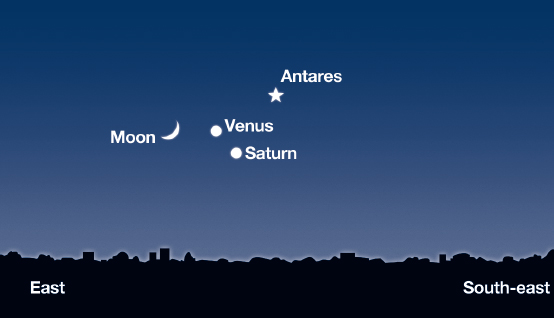

| KEY |
|
|
|
Bright Star |
|
|
Faint Star |
|
|
Magellanic Cloud |
|
|
JUPITER |
This sky map shows the ZODIAC CONSTELLATIONS, Non-Zodiac Constellations and Stars of the night sky as seen from Sydney at:
10.30 pm on 7 February
9.30 pm on 21 February
For other dates subtract or add half an hour each week.
The February night sky is dominated by the constellation of Orion in the northern sky. At the top left or west of the constellation we find the star Rigel, which is the brightest star in the constellation although it is designated as the Beta star. The Alpha star is the reddish star Betelgeuse, at the bottom and right or east of the constellation. Betelgeuse, one of the few stars in the sky with an obvious red colour, is a giant star that is so big that if it replaced the Sun it would engulf Mercury, Venus, the Earth and even Mars.
Extending an imaginary line through the three stars of Orion’s belt to the right or east, we reach Sirius, the brightest star in the sky and the brightest star in the constellation of Canis Major, the Great Dog. Below Sirius is the bright star Procyon, a star that is at a distance of only 11 light years and is a little more massive than the Sun. Its name comes from the Greek meaning ‘before the dog’, a reference to it rising before Sirius, the ‘Dog Star’, in the northern hemisphere.
Taking the imaginary line through Orion’s belt towards the left or west, we reach Aldebaran, the brightest star in the constellation of Taurus, the Bull. Taking the line further, we reach the Pleiades star cluster. Most people can see six stars in the cluster, though some can see a fainter seventh star. Intriguingly, stories from a number of unconnected cultures refer to these stars as ‘seven sisters’.
The Southern Cross, or Crux as it is known to astronomers, is lying on its side in the south-east with the two pointer stars below. Its five naked-eye stars are at different distances from us.

Jupiter is low in the east in Leo just after midmonth. On 23 February the full Moon is above and to the left or north of Jupiter; the next evening, waning gibbous, it is below and to the right or south of Jupiter.
Morning twilight
All five naked-eye planets remain visible in the morning sky.
Mercury is below Venus low in the east, moving from Sagittarius into Capricornus in the middle of the month. On 7 February a very thin crescent Moon is below and to the left or north of the planet.
Venus is in the east, starting the month in Sagittarius but following Mercury into Capricornus just after the middle of the month. On 6 February a thin crescent Moon is above and to the left or north of Venus.
Mars is in the north-east in Libra. On 1 February the last quarter Moon is to the left or north of Mars, while the next morning the now crescent Moon is below and to the right or east of the planet.
Jupiter is in the north-west in Leo. On 24 February the gibbous Moon is below and to the left or west of Jupiter, while the next morning it is above and to the right or north.
Saturn is in the east in Ophiuchus. On 4 February the crescent Moon is below and to the left or north of Saturn.
5:00 am on 6 February — Mercury, Venus and the crescent Moon
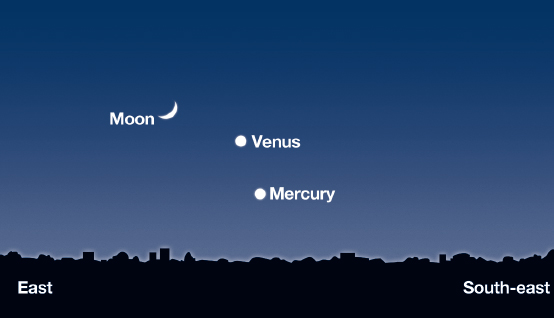
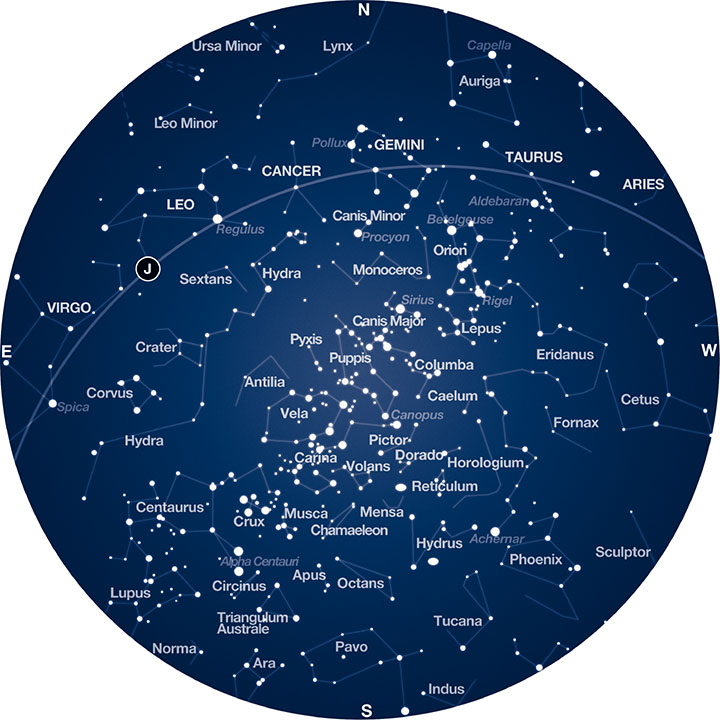
| KEY |
|
|
|
Bright Star |
|
|
Faint Star |
|
|
Magellanic Cloud |
|
|
JUPITER |
This sky map shows the ZODIAC CONSTELLATIONS, Non-Zodiac Constellations and Stars of the night sky as seen from Sydney at:
9.30 pm on 7 March
8.30 pm on 21 March
For other dates subtract or add half an hour each week.
The summer constellation of Orion is high in the north-west. Above and to the right or east is Sirius, the brightest star in the sky. Procyon is below Sirius and further below we find the two bright stars of Gemini, the Twins. Pollux is the star above, while Castor is closer to the horizon. Castor is a fascinating star as telescopes show it to be a triple star, with two bright components and a much fainter one. However, each of these three is also double so, in fact, Castor consists of six stars!
The Southern Cross or Crux is lying on its side in the south-east, with the two pointer stars below. If we extend an imaginary line through the two topmost stars of the Cross to the right or west, we reach the bright star Canopus, high up and almost due south. Canopus is the second brightest star in the sky after Sirius and is the brightest star in the constellation of Carina, the Keel.
Extending another imaginary line towards the right or west, this time through the main axis of the Cross, we reach the star Achernar, the brightest star in the constellation of Eridanus, the River.
Equinox
The autumn equinox occurs when the Sun crosses from the southern to the northern part of the sky. It can take place on 20 or 21 March; this year it is the 20th. On the day of the equinox, the Sun rises close to due east and sets close to due west, while the length of daytime and night time are almost equal at 12 hours each. After the equinox daytime length will decrease until the winter solstice.

Jupiter is the only evening planet, low in the east in Leo. On 22 March the gibbous Moon is below and to the right or south of the planet.
Morning twilight
Mercury is low in the east in Capricornus at the start of the month. It moves into Aquarius after a few days and disappears into the twilight in the middle of the second week. On 8 March a very thin crescent Moon is above and to the left or north of the planet.
Venus is in the east, moving from Capricornus into Aquarius in the middle of the second week of the month. On 7 March a thin crescent Moon is above and to the left or north of Venus.
Mars is high in the north-west, moving from Libra into Scorpius midmonth. On 1 March the gibbous Moon is directly below Mars, while on 29 March it is below and to the right or north of the planet.
Jupiter is low in the west in Leo at the start of the month, disappearing below the horizon early in its second half.
Saturn is in the north-east in Ophiuchus. On 2 March the last quarter Moon is to the left or north of Saturn, while on the next morning the Moon, now at crescent phase, is below and to the right or east of the planet. Then on 30 March the Moon, now gibbous, is again below and to the right or north of Saturn.
8:00 pm on 22 March — Jupiter and the Moon


| KEY |
|
|
|
Bright Star |
|
|
Faint Star |
|
|
Magellanic Cloud |
|
|
JUPITER |
This sky map shows the ZODIAC CONSTELLATIONS, Non-Zodiac Constellations and Stars of the night sky as seen from Sydney at:
7.30 pm on 7 April
6.30 pm on 21 April
For other dates subtract or add half an hour each week.
The summer constellation of Orion is lying on its side in the western sky. Sirius, the brightest star in the sky, is above and to the left or south of Orion. Procyon, the brightest star in the constellation of Canis Minor, the Little Dog, is above and to the right or north.
In the east we can see the bright star Spica, the brightest star in the constellation of Virgo, the Maiden. Spica consists of two hot massive stars whirling around each other every four days.
In the south the Southern Cross is straightening up and is now at about the four o’clock angle. The first of the two pointers below is Beta Centauri, also known as Hadar, which is a hot giant star about 390 light years from us.
The second pointer is Alpha Centauri or Rigel Kentaurus. With a small telescope you can see a pair of bright stars close together — one of the best sights in the southern sky. A third star in the Alpha Centauri system, called Proxima Centauri, is the closest star to the Sun at a distance of 4.3 light years.
The two pointer stars are part of the constellation of Centaurus, the Centaur, which surrounds the Southern Cross on three sides. In Greek mythology centaurs were war-like creatures, half-horse and half-human.
The star Canopus, the second brightest star in the sky and the brightest star in the constellation of Carina, the Keel, is high in the south.

Jupiter remains the only evening planet.
Jupiter is in the north-east in Leo. On 18 April the gibbous Moon is to the right or east of the planet.
Morning twilight
Venus is low in the east, starting the month in Aquarius and moving after a couple of days into Pisces where it stays, apart from a brief excursion into Cetus, until the end of the month. On 6 April a very thin crescent Moon is above and to the left or north of the planet.
Mars is in the west; it is in Scorpius at the start of the month but moves into Ophiuchus to join Saturn after a few days. On 25 April the gibbous Moon is below and to the right or north of the planet.
Saturn is in the west in Ophiuchus. On 26 April the gibbous Moon is below and to the right or north of Saturn.
6:30 pm on 18 April — Jupiter and the Moon


| KEY |
|
|
|
Bright Star |
|
|
Faint Star |
|
|
Magellanic Cloud |
|
|
MARS |
|
|
JUPITER |
This sky map shows the ZODIAC CONSTELLATIONS, Non-Zodiac Constellations and Stars of the night sky as seen from Sydney at:
6.30 pm on 7 May
5.30 pm on 21 May
For other dates subtract or add half an hour each week.
The summer constellation of Orion is lying on its side low in the western sky. Above and to the left or south is the brightest star in the sky, Sirius, while above and to the right or north is Procyon. Further north we see Pollux and Castor, the twin stars of Gemini. Due north is Regulus, the brightest star in the constellation of Leo, the Lion. Regulus lies on the ecliptic, the line traced out by the planets, the Moon in its monthly journey, and the Sun in its annual journey around the sky. Hence Regulus is often occulted, or covered, by the Moon.
Low in the east we have the welcome return of the favourite constellation of the Australian winter sky, Scorpius, the Scorpion. It is easily recognisable, consisting of a line of bright stars, including the bright red star Antares. Scorpius rises as Orion is setting, recalling the ancient Greek story of the Scorpion chasing the giant Orion.
The Southern Cross is well placed for observation as it is now high in the south-east. The brightest star of the Cross, Acrux, is the closest to the horizon, while the next brightest, Beta Crucis or Mimosa, is to the left or east.
Meteor shower
The Eta Aquariids occur this month. Associated with Halley’s Comet, this meteor shower is one of the best to be seen from the southern hemisphere. Look for it in the eastern sky in the early morning of Friday 6 May. An almost new Moon provides an excellent opportunity to try to sight the meteors this year.

Mars and Saturn join Jupiter in the evening sky.
Mars appears low in the south-east in Scorpius after the first week of the month; it moves into Libra at the end of the month. On 21 May the gibbous Moon is to the left or east of Mars, while the next evening the Moon, now full, is below the planet. It is then at opposition with the Sun and at its brightest (see page).
Jupiter is still in the north-east in Leo. On 15 May the gibbous Moon is just above Jupiter; less than three moon-widths separate the two bodies.
Saturn appears low in the south-east in Ophiuchus during the second half of the month.
Morning twilight
Mercury appears low in the eastern sky in Aries just after midmonth.
Venus is very low in the east in Aries, where it had moved from Pisces at the beginning of the month. On 14 May it is in close conjunction with Mercury; binoculars are needed to see the fainter planet. Venus disappears into the twilight in the middle of the month.
Mars is in the western sky.
Saturn is in the west in Ophiuchus. On 23 May the gibbous Moon is below and to the right or north of the planet.
6:00 pm on 15 May — Mars, Jupiter and the Moon


| KEY |
|
|
|
Bright Star |
|
|
Faint Star |
|
|
Magellanic Cloud |
|
|
MARS |
|
|
JUPITER |
|
|
SATURN |
This sky map shows the ZODIAC CONSTELLATIONS, Non-Zodiac Constellations and Stars of the night sky as seen from Sydney at:
6.30 pm on 7 June
5.30 pm on 21 June
For other dates subtract or add half an hour each week.
The signpost to the winter sky, the constellation of Scorpius, the Scorpion, is prominent in the east. With its head or claws to the left or north and its tail to the right or south, it is one of the few constellations that has a resemblance to its name. The Scorpion even has a red heart, the star Antares. This is a red giant star at a distance of 550 light years from us and a width that is about four times that of the Earth’s path around the Sun.
Further to the north we see the bright star Spica, the brightest star in the constellation of Virgo, high in the north-east. Below is the brilliant orange-coloured Arcturus of the constellation of Boötes. This star, at a distance of 37 light years from us, has an exceptionally low concentration of elements other than hydrogen and helium.
In the north-east we reach Regulus, the brightest star in the constellation of Leo, the Lion. Its name comes from the Latin and means the ‘Little King’, as in ancient times the star was considered the ruler of the heavens. A very hot star at a distance of 79 light years from us, it has a flattened and distorted shape due to a very rapid spin around its axis.
Above Regulus and stretching across the sky is the constellation of Hydra, the Female Water Snake. This ancient constellation is the largest of the 88 constellations accepted by modern astronomers.
The Southern Cross or Crux is at its highest and standing vertically in the south. Its brightest star, Acrux, is the one closest to the horizon.

Mars, Jupiter and Saturn are the evening planets.
Mars is in the east in Libra. On 17 June the gibbous Moon is below and to the left or north of the planet.
Jupiter is to the north in Leo. On 11 June the crescent Moon is below and to the left or west of Jupiter, while the next evening the Moon, now at first quarter, is above and to the right or east.
Saturn is in the east in Ophiuchus. On 18 June the gibbous Moon is above and to the left or north of Saturn, while the next evening it is below the planet.
Morning twilight
Mercury is low in the north-east, moving after the first week of the month from Aries into Taurus and disappearing into the twilight during the last week. On 3 June a thin crescent Moon is above and to the left or north of Mercury, while the next morning it is below and to the right or east of the planet.
Mars is low in the south-west at the start of the month but disappears after a few days.
Saturn is low in the west but disappears below the horizon in the middle of the month.
6:00 pm on 18 June — Mars, Saturn and the Moon


| KEY |
|
|
|
Bright Star |
|
|
Faint Star |
|
|
Magellanic Cloud |
|
|
MERCURY ON 21 JULY |
|
|
VENUS ON 21 JULY |
|
|
MARS |
|
|
JUPITER |
|
|
SATURN |
This sky map shows the ZODIAC CONSTELLATIONS, Non-Zodiac Constellations and Stars of the night sky as seen from Sydney at:
6.30 pm on 7 July
5.30 pm on 21 July
For other dates subtract or add half an hour each week.
Scorpius, the Scorpion, with its curved line of bright stars is high in the eastern sky. Below it is the constellation of Sagittarius, the Archer. In old drawings of the constellation, the Archer is depicted as a centaur — a half-human and half-horse creature like the constellation Centaurus. The common name of Sagittarius, however, is the Teapot. The aptness of this name can be verified in a quick glance at the stars of the constellation, with the handle below, the spout above and the lid to the left or north.
Spica, the brightest star in the constellation of Virgo, is high in the north. This star, at a distance of 250 light years from us, consists of two hot and massive stars whirling around each other every four days. They are so close that they cannot be seen as separate stars through a telescope. Instead, astronomers use a device called a spectrograph, which breaks the starlight into its component colours and allows them to measure the velocities of the two stars as they alternately approach and move away from us.
Below Spica we find the brilliant orange-coloured Arcturus, the brightest star in the constellation of Boötes, the Herdsman. July is the best time to view this star, which is one of the brightest as viewed from the northern hemisphere.
The Southern Cross is high in the south with the pointer stars almost horizontal. The pointer stars are part of the large constellation of Centaurus, the Centaur, which surrounds the Cross on three sides.

Mercury and Venus join Mars, Jupiter and Saturn in the evening sky.
Mercury appears low in the north-west in Cancer during the second half of the month but crosses into Leo after a few days. On 30 and 31 July Mercury passes Regulus, the brightest star in Leo, with a separation less than two moon-widths.
Venus appears low the north-west in the beginning of the month. It starts the month in Gemini, moves into Cancer after a few days and moves into Leo at the end of the month. On 5 July a very thin crescent Moon may be just visible above and to the left or west of Venus. On 17 July Venus is in conjunction with Mercury at a separation of just over one moon-width; binoculars will make it easier to see Mercury.
Mars is in the eastern sky in Libra. On 14 July the gibbous Moon is below and left or north of Mars, while the next evening it is below the planet.
Jupiter is in the north-west in Leo. On 9 July the crescent Moon is less than three moon-widths from Jupiter, below and to the left or west.
Saturn is in the east in Ophiuchus. On 16 July the gibbous Moon is below and to the left or north of the planet.
Morning twilight
No planets
5:30 pm on 5 July — Venus and the crescent Moon


| KEY |
|
|
|
Bright Star |
|
|
Faint Star |
|
|
Magellanic Cloud |
|
|
MERCURY ON 21 AUGUST |
|
|
VENUS ON 21 AUGUST |
|
|
MARS |
|
|
JUPITER |
|
|
SATURN |
This sky map shows the ZODIAC CONSTELLATIONS, Non-Zodiac Constellations and Stars of the night sky as seen from Sydney at:
7.30 pm on 7 August
6.30 pm on 21 August
For other dates subtract or add half an hour each week.
The constellation of Sagittarius, the Archer, is high in the eastern sky. More commonly known as the Teapot, the handle is below and the spout above. The lower star on the left or north of the handle has the name Nunki, of Babylonian origin. At a distance of 225 light years from us, the star is fast-spinning and exceptionally hot.
Above Sagittarius we find the curved line of bright stars forming Scorpius, the Scorpion, almost directly overhead. Its claws lie towards the west, while the tail is towards the east. Antares, the Scorpion’s red heart, shines brightly near the zenith. Its name means ‘Rival of Mars’, as the planet Mars is a similar colour and can have a similar brightness.
In the north-east we see the bright star Altair, the brightest star in the constellation of Aquila, the Eagle. Altair can be easily recognised as it is flanked by two stars, Tarazed to the left or north and Alshain to the right or east.
Closer to the horizon than Altair and to its left or north, we see the bright northern hemisphere star Vega, the brightest star in the constellation of Lyra, the Lyre. Thirteen thousand years ago Vega marked the pole in the northern hemisphere sky just as Polaris does today.
In the southern part of the sky the Southern Cross is high in the southwest. Though we normally think of the Cross as consisting of five bright stars, the fifth star Epsilon is becoming difficult to see from our over-lit cities and suburbs. Epsilon appears faint to us because of its great distance of 228 light years from Earth.

All five naked-eye planets are visible in the evening sky.
Mercury is low in the west, starting the month in Leo but moving to join Jupiter in Virgo during the second half of the month. On 5 August a thin crescent Moon is above and to the right or north of the planet.
Venus is low in the west, moving from Leo to Virgo near the end of the month. On 4 August a very thin crescent Moon is above and to the left or south of Venus. Late in the month Venus approaches Jupiter with the closest conjunction on 28 August less than a moon-width.
Mars is high in the north, moving from Libra into Scorpius at the start of the month. Near the end, Mars approaches red Antares, the brightest star in Scorpius; they are within four moon-widths of each other 23–26 August. On 24 August Antares, Mars and Saturn form a straight line.
Jupiter is in the west, moving from Leo to Virgo during the second week of the month. On 6 August a thin crescent Moon is above and to the right or north of Jupiter at a separation of about three moon-widths.
Saturn is in the north-east in Ophiuchus. On 12 August the gibbous Moon is below and to the left or north of the planet.
Morning twilight
No planets
6:30 pm on 24 August — five planets

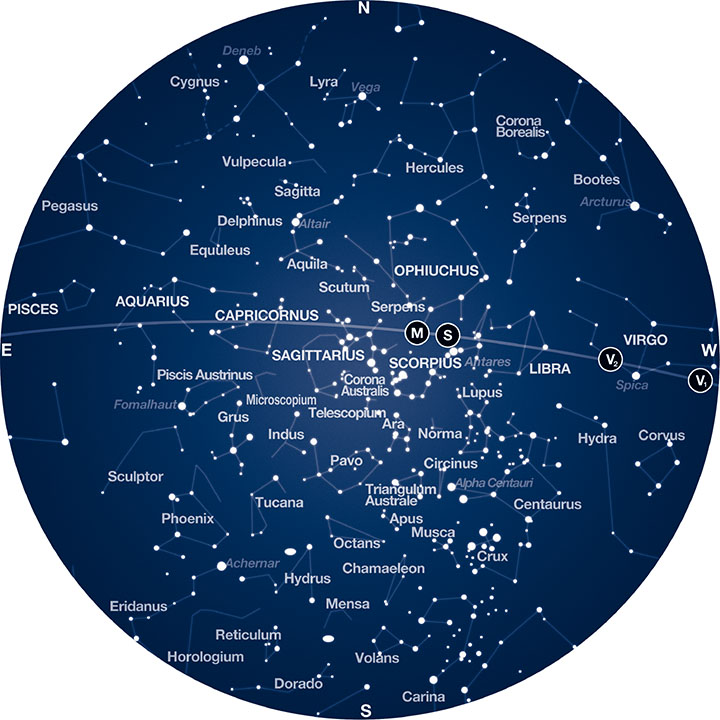
| KEY |
|
|
|
Bright Star |
|
|
Faint Star |
|
|
Magellanic Cloud |
|
|
VENUS ON 7 SEPTEMBER |
|
|
VENUS ON 21 SEPTEMBER |
|
|
MARS |
|
|
SATURN |
This sky map shows the ZODIAC CONSTELLATIONS, Non-Zodiac Constellations and Stars of the night sky as seen from Sydney at:
7.30 pm on 7 September
6.30 pm on 21 September
For other dates subtract or add half an hour each week.
The constellation of Sagittarius, the Archer, is overhead while Scorpius, the Scorpion, with its bright red star Antares is high in the western sky.
Altair, the brightest star in the constellation of Aquila, the Eagle, is prominent in the north together with its two attendant stars, one on either side. Below Altair and due north, we find Vega, the brightest star in the constellation of Lyra, the Lyre. September is the best time to see this star, which is prominent from the northern hemisphere as it is below our horizon for most of the year.
A little south of east we can see Fomalhaut, the brightest star in the constellation of Pisces Austrinus, the Southern Fish. The star is 25 light years from us and is surrounded by a disc of dusty debris, within which astronomers have detected a planet circling the star.
The Southern Cross is almost on its side in the south-west. If we extend an imaginary line through the main axis of the Cross towards the left or east, near the horizon we reach Achernar, the brightest star of the constellation of Eridanus, the River.
Equinox
The spring equinox occurs when the Sun crosses from the northern to the southern part of the sky. Until 2020 this takes place on 23 September each year. On this day, as at the autumn equinox in March, the Sun rises close to due east and sets close to due west.

Mercury and Jupiter disappear from the evening sky, leaving Venus, Mars and Saturn as the evening planets.
Mercury is low in the west in Virgo, disappearing into the twilight at the end of the first week of the month.
Venus is in the west racing through Virgo during the month and reaching Libra at its end. On 3 September a very thin crescent Moon is below Venus. On 19 Venus passes Spica, the brightest star in Virgo, at a separation of five moon-widths.
Mars is high in the north-west, moving from Scorpius into Ophiuchus at the beginning of the month and then into Sagittarius during its second half. On 9 September the first quarter Moon is below and to the right or north of Mars.
Jupiter is below Venus low in the west in Virgo at the start of the month but disappears into the twilight during the second week of the month.
Saturn is in the west in Ophiuchus. On 8 September the crescent Moon is below the planet.
Morning twilight
No planets
6:45 pm on 3 September — Mercury, Venus, Jupiter and the crescent Moon


| KEY |
|
|
|
Bright Star |
|
|
Faint Star |
|
|
Magellanic Cloud |
|
|
VENUS ON 7 OCTOBER |
|
|
VENUS ON 21 OCTOBER |
|
|
MARS |
|
|
SATURN |
This sky map shows the ZODIAC CONSTELLATIONS, Non-Zodiac Constellations and Stars of the night sky as seen from Sydney at:
8.30 pm on 7 October
7.30 pm on 21 October
For other dates subtract or add half an hour each week.
Scorpius, the Scorpion, is upside down low in the western sky. Its claws are near the horizon while its tail is up in the sky. At the end of the long tail we find the star Shaula, coming from an Arabic phrase meaning ‘the sting’. At a distance of 365 light years from us, Shaula is an interesting triple star system with two hot massive stars and a third star that could be a white dwarf star (a compact and dense object) or a star that is still forming.
Altair, the brightest star in the constellation of Aquila, the Eagle, is high in the northern sky. This star is relatively close by at a distance of 17 light years from Earth. Intrinsically it is about 10 times brighter than the Sun and spins around its axis in an exceptionally short period of about 10 hours.
The Southern Cross is lying on its side, low in the south-west. The brightest star of the Cross is Acrux on the left or east of the constellation. This is made up of two hot stars that take over a thousand years to circle around each other. A spectrograph shows that one of these components is itself double, with its two stars racing around each other every 76 days.
The Southern Cross can be used to find south. Extending a line through its main axis to the left or east, we reach Achernar, the brightest star in the constellation of Eridanus, the River. Halfway along the line is the South Celestial Pole (SCP), the point in the sky about which all the stars in the sky appear to circle every 24 hours.

Venus has a conjunction with Saturn and remains one of the three evening planets.
Venus is low in the west moving from Libra into Scorpius in the middle of the month and then a week later into Ophiuchus. On 3 October a thin crescent Moon is below and to the right or north of the planet. On 5–6 October Venus passes close by the star Zubenelgenubi, while on 27 October Venus passes by Antares, the brightest star in Scorpius, at a separation of about six moon-widths. The next evening Venus is almost exactly halfway between Antares and Saturn.
Mars is high in the west in Sagittarius. On 8 October the crescent Moon is below and to the right or north of Mars. On 15–16 October Mars passes about three moon-widths from a star with the Babylonian name Nunki.
Saturn is in the west in Ophiuchus to the right or north of Antares, the brightest star of the adjacent constellation of Scorpius. On 6 October the crescent Moon is below and to the right or north of the planet.
Morning twilight
Jupiter appears low in the east in Virgo during the last week of the month. On 28 October a very thin crescent Moon is above and to the left or north of Jupiter.
8:30 pm on 28 October — Venus, Saturn and a star


| KEY |
|
|
|
Bright Star |
|
|
Faint Star |
|
|
Magellanic Cloud |
|
|
MERCURY ON 21 NOVEMBER |
|
|
VENUS ON 7 NOVEMBER |
|
|
VENUS ON 21 NOVEMBER |
|
|
MARS |
|
|
SATURN |
This sky map shows the ZODIAC CONSTELLATIONS, Non-Zodiac Constellations and Stars of the night sky as seen from Sydney at:
9.30 pm on 7 November
8.30 pm on 21 November
For other dates subtract or add half an hour each week.
Pegasus, the Winged Horse, is in the northern sky. This is the best time of the year to see this famous northern hemisphere constellation. Though it lacks bright stars, it is easily recognisable with the help of four stars outlining ‘the great square of Pegasus’.
In the south-west Scorpius, the Scorpion, is disappearing below the horizon with only the stars of the tail visible. Over in the east Rigel, the brightest star in the constellation of Orion, the Hunter, is just rising above the horizon. This is the reverse of the situation earlier in the year in May, and again reflects the Scorpion’s perpetual chase of the giant Orion.
Another star that is making a return to the evening sky this month is Canopus, the second brightest star in the sky and the brightest star in the constellation of Carina, the Keel. This constellation is one of three nautically themed constellations adjacent to each other in the sky. The other two, Vela, the Sails, and Puppis, the Stern, will be better seen next month. Together with Carina they made up the ancient constellation of Argo Navis, the Ship, before it was split.
The Southern Cross is upside down in the south and so low in the sky that trees and houses easily block it from sight. There are, however, other bright stars visible in the southern part of the sky such as Fomalhaut, the brightest star of Pisces Austrinus, the Southern Fish, which is almost overhead. If we draw an imaginary line from Fomalhaut to Canopus, about halfway we find Achernar, a hot star at a distance of 140 light years from Earth and the brightest star of Eridanus, the River.

Mercury appears and passes close to Saturn, which disappears late in the month.
Mercury appears low in the south-west in Ophiuchus just after the middle of the month. It passes by Saturn on 22 November.
Venus is in the west, moving from Ophiuchus into Sagittarius after the first week of the month. On 3 November a thin crescent Moon is below and to the right or north of the planet.
Mars is in the west, moving from Sagittarius into Capricornus after the first week of the month. On 6 November the crescent Moon is below and to the right or north of Mars.
Saturn is low in the west in Ophiuchus but disappears into the twilight during the last week of the month. On 2 November a thin crescent Moon is directly below the planet.
Morning twilight
Jupiter is low in the east in Virgo. On 25 November the crescent Moon is to the left or north of Jupiter.
8:30 pm on 3 November — Venus, Mars, Saturn and the crescent Moon

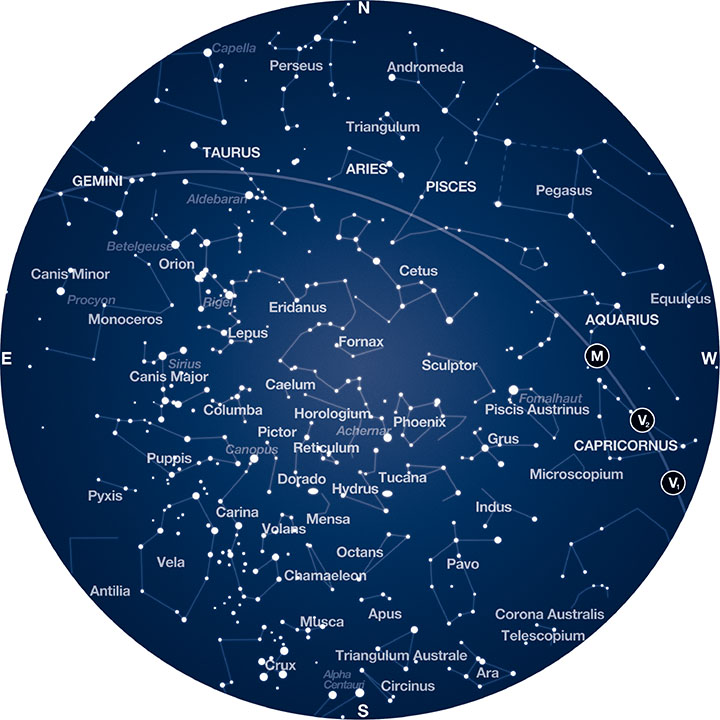
| KEY |
|
|
|
Bright Star |
|
|
Faint Star |
|
|
Magellanic Cloud |
|
|
VENUS ON 7 DECEMBER |
|
|
VENUS ON 21 DECEMBER |
|
|
MARS |
This sky map shows the ZODIAC CONSTELLATIONS, Non-Zodiac Constellations and Stars of the night sky as seen from Sydney at:
10.30 pm on 7 December
9.30 pm on 21 December
For other dates subtract or add half an hour each week.
The summer constellation of Orion, the Hunter, is high in the south-east. The three stars in the middle of the constellation represent the belt of Orion. Above and a little further to the right or east of the rightmost star of the belt, we find a line of three faint objects, which make up the dagger or sword of Orion. In the middle is one of the most famous sights in the sky, the Great Nebula in Orion. From a city or suburban location, the ‘sword’ is best seen through binoculars.
Extending a line through the stars of the belt towards the right or east, we reach Sirius, the brightest star in the sky. Extending the line in the other direction, we find Aldebaran, the brightest star in the constellation of Taurus, the Bull. Aldebaran’s outer layers are cooler than those of the Sun so it has a noticeably orange colour.
If we extend the line from Orion’s belt further to the left or west, we reach the Pleiades star cluster. To the unaided eye only six or seven stars are visible in the cluster, but through a telescope hundreds of them can be seen. They are at a distance of around 400 light years.
Meteor shower
The Geminid shower, one of the year’s best meteor showers, is normally a highlight this month. To see the meteors, look towards the north on the early morning of Wednesday 14 December. Unfortunately, with the Moon full and brightening the night sky on that date, seeing any but the brightest meteors is likely to be difficult.

Mercury disappears, leaving Venus and Mars as the evening planets.
Mercury is low in the south-west in Sagittarius, having moved there from Ophiuchus at the beginning of the month. It disappears into the twilight just after the middle of the month. On 2 December a thin crescent Moon is above and to the right or west of the planet.
Venus is in the west, moving from Sagittarius into Capricornus at the end of the first week of the month. On 3 December the crescent Moon is below and to the right or north of Venus.
Mars is in the west, moving from Capricornus into Aquarius in the middle of the month. On 5 December the crescent Moon is below and to the right or north of the planet.
Morning twilight
Jupiter is in the east in Virgo. On 23 December the crescent Moon is below and to the left or north of Jupiter.
Saturn appears low in the south-east in Ophiuchus for the last few days of the month.
9:00 pm on 3 December — Mercury, Venus, Mars and the crescent Moon
